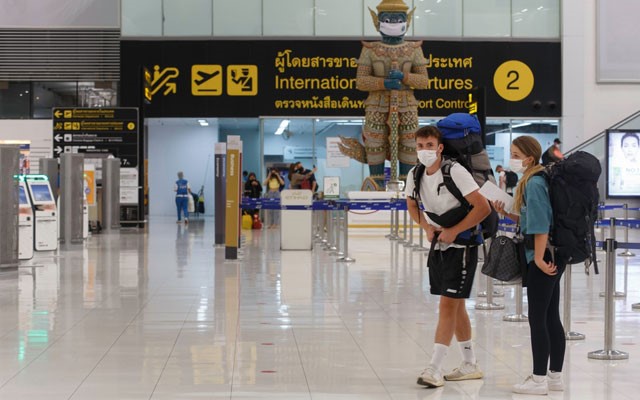While global tourism experienced a four per cent upturn in 2021 compared to 2020 (415 million versus 400 million), international tourist arrivals (overnight visitors) were still 72 per cent below the pre-pandemic year of 2019, according to preliminary estimates by UNWTO.
This follows on from 2020, the worst year on record for tourism, when international arrivals decreased by 73 per cent.
Arrivals in the Asia-Pacific region for 2021 down 94 per cent as compared to 2019 levels; tourists at Suvarnabhumi Airport in Thailand pictured
The first 2022 issue of the UNWTO World Tourism Barometer indicates that rising rates of vaccination, combined with easing of travel restrictions due to increased cross-border coordination and protocols, have all helped release pent-up demand.
International tourism rebounded moderately during 2H2021, with international arrivals down 62 per cent in both 3Q and 4Q compared to pre-pandemic levels. According to limited data, international arrivals in December were 65 per cent below 2019 levels. The full impact of the Omicron variant and surge in Covid-19 cases is yet to be seen, said UNWTO.
The pace of recovery remains slow and uneven across world regions due to varying degrees of mobility restrictions, vaccination rates and traveller confidence. Europe and the Americas recorded the strongest results in 2021 compared to 2020 (+19 per cent and +17 per cent respectively), but both still 63 per cent below pre-pandemic levels.
By subregion, the Caribbean saw the best performance (+63 per cent above 2020, though 37 per cent below 2019), with some destinations coming close to, or exceeding pre-pandemic levels. Southern Mediterranean Europe (+57 per cent) and Central America (+54 per cent) also enjoyed a significant rebound but remain 54 per cent and 56 per cent down on 2019 levels respectively. North America (+17 per cent) and Central Eastern Europe (+18 per cent) also climbed above 2020 levels.
Meanwhile, Africa saw a 12 per cent increase in arrivals in 2021 compared to 2020, though this is still 74 per cent below 2019. In the Middle East, arrivals declined 24 per cent compared to 2020 and 79 per cent over 2019. In Asia and the Pacific, arrivals were still 65 per cent below 2020 levels and 94 per cent when compared to pre-pandemic values as many destinations remained closed to non-essential travel.
























